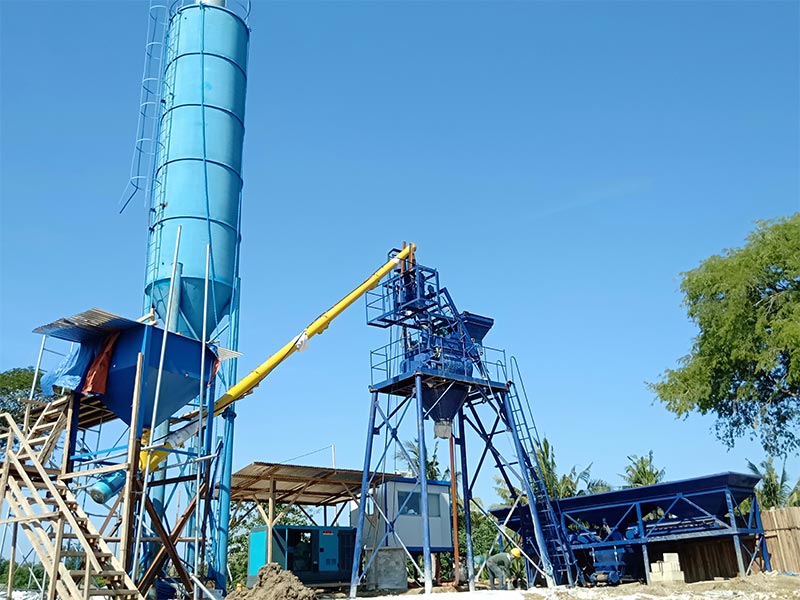Choosing the Right Concrete Batching Plant
A concrete batching plant, also known as a concrete mixing plant or a concrete batch plant, is a facility where various ingredients are combined to produce concrete. These ingredients typically include cement, water, aggregates (such as sand, gravel, or crushed stone), and admixtures (chemical additives that enhance specific properties of concrete). Concrete batching plants provide a controlled environment for accurate and efficient mixing, ensuring the desired concrete quality and consistency.
How Does a Concrete Batching Plant Work?
The operation of a concrete batching plant involves several steps:
a) Aggregate Batching
The aggregates are measured and batched according to the desired mix design. This process involves weighing the aggregates and transferring them to storage bins or hoppers.
b) Cement and Admixture Addition
Cement and admixtures are precisely measured and added to the mix. The cement is typically stored in silos and conveyed to the weighing system, where it is accurately dispensed. Admixtures are added in specific quantities to improve the workability, durability, or curing properties of the concrete.
c) Water Addition
Water is carefully added to achieve the desired water-cement ratio. The water is typically measured using a water meter or by weight.
d) Mixing
The ingredients are thoroughly mixed to ensure a homogeneous concrete mixture. The mixing process can be performed using various methods, such as a twin-shaft mixer, planetary mixer, or drum mixer.
e) Discharging
Once the mixing is complete, the concrete is discharged from the mixer into trucks, ready for transportation to the construction site.

Components of a Concrete Batching Plant
A concrete batching plant consists of several key components:
a) Aggregate Bins or Hoppers
These storage compartments hold the various aggregates used in concrete production. They are equipped with gates or conveyor systems for accurate and controlled discharge of the aggregates.
b) Cement Silos
Cement silos store the cement used in concrete production. They are designed to keep the cement dry and protect it from external elements.
c) Weighing System
A weighing system is responsible for accurately measuring the aggregates, cement, water, and admixtures. It ensures the correct proportions are maintained for consistent concrete quality.
d) Mixing Unit
The mixing unit comprises a mixer, which blends the ingredients to create the concrete mixture. Different types of mixers can be used, depending on the specific requirements of the project.
e) Control Panel
The control panel allows operators to monitor and control the batching plant's functions, such as ingredient weighing, mixing time, and discharge operations.
Additional reading:How many types of steam boilers are there?
What is the main purpose of Valve?
How does metal plating machines work?
How to choose the right foam cutting machine?
What are the stages of battery manufacturing?
Advantages of Galvanizing Kettle for Purchase Stage?
What is the best strapping material?
Types of Concrete Batching Plants
Concrete batching plants can be classified into various types based on their configuration, capacity, and mobility. Some common types include:
a) Stationary Concrete Batching Plant
Stationary plants are designed for long-term use at a specific location. They offer high production capacity and are suitable for large-scale construction projects.
b) Mobile Concrete Batching Plant
Mobile concrete batching plants are portable and can be easily transported from one site to another. They are ideal for smaller projects or sites with limited space.
c) Compact Concrete Batching Plant
Compact plants are a combination of stationary and mobile plants, offering both high production capacity and mobility. They are designed to be easily transported and set up at different locations.
Advantages of Using a Concrete Batching Plant
Using a concrete batching plant offers several advantages:
a) Increased Efficiency
Concrete batching plants streamline the concrete production process, allowing for high-speed mixing and continuous production. This results in increased efficiency and shorter construction timelines.
b) Consistent Quality
By precisely measuring and controlling the ingredients, concrete batching plants ensure consistent quality and uniformity in the produced concrete. This consistency is crucial for construction projects that require strict adherence to specifications.
c) Customization Options
Concrete batching plants allow for the customization of concrete mix designs to meet specific project requirements. Different proportions of aggregates, cement, and admixtures can be adjusted to achieve the desired strength, durability, and workability of the concrete.
d) Reduced Labor Costs
Automation features in modern concrete batching plants reduce the reliance on manual labor, leading to cost savings in terms of labor expenses.
Choosing the Right Concrete Batching Plant
When selecting a concrete batching plant, consider the following factors:
a) Project Requirements
Assess the specific needs of your project, such as the required production capacity, type of concrete mix, and project duration.
b) Available Space
Consider the available space at the construction site to determine the appropriate size and configuration of the batching plant.
c) Budget and Cost Considerations
Evaluate the investment cost, operational costs, and potential cost savings associated with different types and models of concrete batching plants.
Additional reading:How Ballistic Separator Recycling is Revolutionizing Waste Sorting
What is the disadvantage of BYD Blade battery?
Exploring the Most Popular Metal Plating Techniques
Ultimate Guide to 4 Side Sealing Machine: All Your Questions Answered
What is the significance of Compressed Waste in B2B marketing?
Revolutionizing India's Battery Production with Cutting-Edge Equipment
Ultimate Guide to the Perfect Nickel Plating
Related Articles
If you are interested in sending in a Guest Blogger Submission,welcome to write for us!












Comments
0